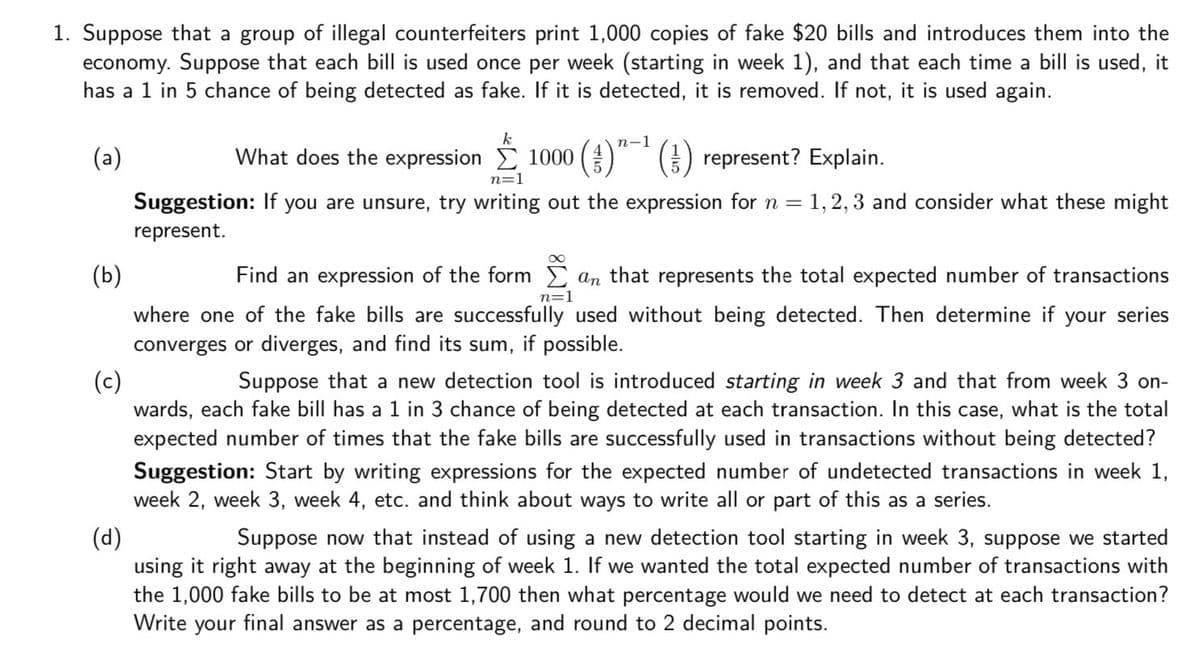1. Suppose that a group of illegal counterfeiters print 1,000 copies of fake $20 bills and introduces them into the economy. Suppose that each bill is used once per week (starting in week 1), and that each time a bill is used, it has a 1 in 5 chance of being detected as fake. If it is detected, it is removed. If not, it is used again. n-1 (a) What does the expression 1000 (" ) represent? Explain. n=1 Suggestion: If you are unsure, try writing out the expression for n = 1, 2, 3 and consider what these might represent. (b) Find an expression of the form an that represents the total expected number of transactions n=1 where one of the fake bills are successfully used without being detected. Then determine if your series converges or diverges, and find its sum, if possible. (c) wards, each fake bill has a 1 in 3 chance of being detected at each transaction. In this case, what is the total expected number of times that the fake bills are successfully used in transactions without being detected? Suppose that a new detection tool is introduced starting in week 3 and that from week 3 on- Suggestion: Start by writing expressions for the expected number of undetected transactions in week 1, week 2, week 3, week 4, etc. and think about ways to write all or part of this as a series.
1. Suppose that a group of illegal counterfeiters print 1,000 copies of fake $20 bills and introduces them into the economy. Suppose that each bill is used once per week (starting in week 1), and that each time a bill is used, it has a 1 in 5 chance of being detected as fake. If it is detected, it is removed. If not, it is used again. n-1 (a) What does the expression 1000 (" ) represent? Explain. n=1 Suggestion: If you are unsure, try writing out the expression for n = 1, 2, 3 and consider what these might represent. (b) Find an expression of the form an that represents the total expected number of transactions n=1 where one of the fake bills are successfully used without being detected. Then determine if your series converges or diverges, and find its sum, if possible. (c) wards, each fake bill has a 1 in 3 chance of being detected at each transaction. In this case, what is the total expected number of times that the fake bills are successfully used in transactions without being detected? Suppose that a new detection tool is introduced starting in week 3 and that from week 3 on- Suggestion: Start by writing expressions for the expected number of undetected transactions in week 1, week 2, week 3, week 4, etc. and think about ways to write all or part of this as a series.
Algebra & Trigonometry with Analytic Geometry
13th Edition
ISBN:9781133382119
Author:Swokowski
Publisher:Swokowski
Chapter10: Sequences, Series, And Probability
Section10.8: Probability
Problem 32E
Related questions
Question

Transcribed Image Text:1. Suppose that a group of illegal counterfeiters print 1,000 copies of fake $20 bills and introduces them into the
economy. Suppose that each bill is used once per week (starting in week 1), and that each time a bill is used, it
has a 1 in 5 chance of being detected as fake. If it is detected, it is removed. If not, it is used again.
k
п-1
(a)
What does the expression E 1000 ( ) represent? Explain.
n=1
Suggestion: If you are unsure, try writing out the expression forn = 1,2, 3 and consider what these might
represent.
(b)
Find an expression of the form E an that represents the total expected number of transactions
n=1
where one of the fake bills are successfully used without being detected. Then determine if your series
converges or diverges, and find its sum, if possible.
(c)
wards, each fake bill has a 1 in 3 chance of being detected at each transaction. In this case, what is the total
expected number of times that the fake bills are successfully used in transactions without being detected?
Suppose that a new detection tool is introduced starting in week 3 and that from week 3 on-
Suggestion: Start by writing expressions for the expected number of undetected transactions in week 1,
week 2, week 3, week 4, etc. and think about ways to write all or part of this as a series.
(d)
using it right away at the beginning of week 1. If we wanted the total expected number of transactions with
the 1,000 fake bills to be at most 1,700 then what percentage would we need to detect at each transaction?
Write your final answer as a percentage, and round to 2 decimal points.
Suppose now that instead of using a new detection tool starting in week 3, suppose we started
Expert Solution
This question has been solved!
Explore an expertly crafted, step-by-step solution for a thorough understanding of key concepts.
Step by step
Solved in 2 steps

Recommended textbooks for you

Algebra & Trigonometry with Analytic Geometry
Algebra
ISBN:
9781133382119
Author:
Swokowski
Publisher:
Cengage

College Algebra
Algebra
ISBN:
9781305115545
Author:
James Stewart, Lothar Redlin, Saleem Watson
Publisher:
Cengage Learning

Algebra & Trigonometry with Analytic Geometry
Algebra
ISBN:
9781133382119
Author:
Swokowski
Publisher:
Cengage

College Algebra
Algebra
ISBN:
9781305115545
Author:
James Stewart, Lothar Redlin, Saleem Watson
Publisher:
Cengage Learning